Desert plants make excellent natural fences that require minimal water while providing beauty and security. Consider ocotillo for height up to 20 feet, Mexican fence post cactus for privacy, or prickly pear for a dense barrier. Other tough options include desert willow, agave species, Texas sage, jojoba, creosote bush, and desert ironwood. These living boundaries attract wildlife, improve soil health, and blend seamlessly with arid landscapes. Discover how these resilient plants can transform your property perimeter.
The Benefits of Living Desert Fences

While traditional fencing materials like wood and metal require regular maintenance and offer limited ecological value, living desert fences provide numerous advantages for homeowners in arid regions.
By utilizing native plants like ocotillo and creosote bush, you’ll create barriers that thrive with minimal water while enhancing privacy.
Native desert plants transform boundary lines into thriving ecosystems that protect your privacy while conserving precious water resources.
These desert shrubs do more than just mark boundaries—they improve soil health through their deep root systems, preventing erosion and enriching the ground naturally.
You’ll also boost biodiversity as these living fences attract local wildlife, especially pollinators and birds that benefit your entire garden.
The aesthetic appeal of these natural barriers can’t be overstated.
Their unique textures and colors blend seamlessly with the landscape, creating a visually striking boundary that requires low maintenance while contributing to a more sustainable environment.
Ocotillo (Fouquieria Splendens): the Classic Desert Fence
Sentinels of the desert landscape, ocotillos stand as nature’s perfect living fence with their dramatic upright stems reaching heights of up to 20 feet.
You’ll find these remarkable plants thriving in hardiness zones 7-11, where they create striking barriers while adding architectural interest to desert landscapes.
For successful ocotillo growth, remember:
- Plant in well-drained soil and full sun exposure for ideal development
- Be patient while the deep root system establishes, making it exceptionally drought-tolerant
- Enjoy the vibrant red flowers that appear in spring, attracting crucial pollinators like hummingbirds
- Allow adequate spacing for stems to develop fully, enhancing their effectiveness as a natural fence
Once established, your ocotillo fence will provide both security and beauty with minimal maintenance—perfect for water-conscious gardeners.
Mexican Fence Post Cactus (Pachycereus Marginatus): Nature’s Privacy Screen
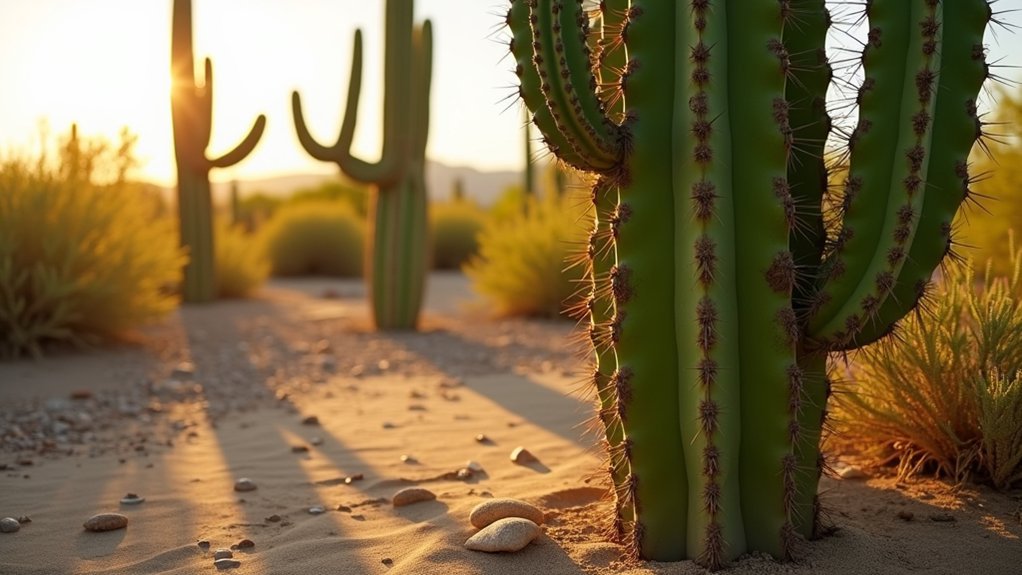
You’ll find the Mexican Fence Post Cactus offers impressive vertical growth reaching 15-20 feet tall, creating a natural privacy screen with its columnar form and distinctive ribs.
These low-maintenance barrier plants thrive in arid conditions with minimal water requirements, perfect for desert landscapes in zones 9-11.
Their protective spines provide a sun-loving security solution while adding architectural interest to your property boundary, effectively deterring both animal and human intruders.
Striking Vertical Growth
Standing tall among desert landscaping options, the Mexican Fence Post Cactus creates an impressive natural boundary that’s as functional as it’s striking. This dramatic succulent reaches heights of up to 15 feet, featuring prominent vertical ribs and spines that showcase remarkable architectural presence in your garden.
- The cactus’s distinctive vertical growth pattern creates an immediate privacy screen, blocking unwanted views while adding desert character.
- You’ll appreciate its resilience to extreme temperatures and poor soil conditions, ensuring your natural barrier thrives for years.
- Its drought-tolerant landscaping credentials make it perfect for USDA hardiness zones 9-11.
- Beyond functionality, you’ll enjoy beautiful white flowers that bloom at night, transforming your practical fence into a nighttime garden feature.
Low-Maintenance Barrier Plants
Despite its impressive stature, the Mexican Fence Post Cactus (Pachycereus marginatus) demands remarkably little attention once established in your landscape. This drought-tolerant desert plant thrives in arid climates, requiring minimal irrigation while growing up to 12 feet tall.
You’ll appreciate how its upright, columnar form creates an effective natural fence with multiple vertical ribs adorned with defensive spines that deter unwanted visitors. Hardy in USDA zones 9-11, this cactus excels where traditional fencing struggles.
The Mexican Fence Post Cactus offers more than security—it delivers beauty too, producing elegant white blooms during summer months.
Plant in well-drained soil and enjoy the perfect combination of functionality and aesthetics without the maintenance headaches of conventional barriers.
Sun-Loving Security Solution
The Mexican Fence Post Cactus thrives in desert landscapes where blistering sun and limited water would kill most traditional privacy screens. As a natural barrier reaching up to 15 feet tall, this columnar cactus serves both beauty and security functions while requiring minimal care in your xeriscaping design.
This tough desert plant offers:
- Impressive security with dense, deterrent spines that discourage unwanted visitors
- Resilience in USDA zones 9-11, withstanding temperatures down to 25°F
- Extremely low water requirements, perfect for drought-prone regions
- Adaptability to well-drained rocky soils common in desert environments
You’ll appreciate how this sun-loving security solution creates an effective living fence while adding architectural interest to your landscape—all without demanding the constant attention that traditional fencing materials require.
Prickly Pear (Opuntia Spp.): Dense and Defensive Barrier
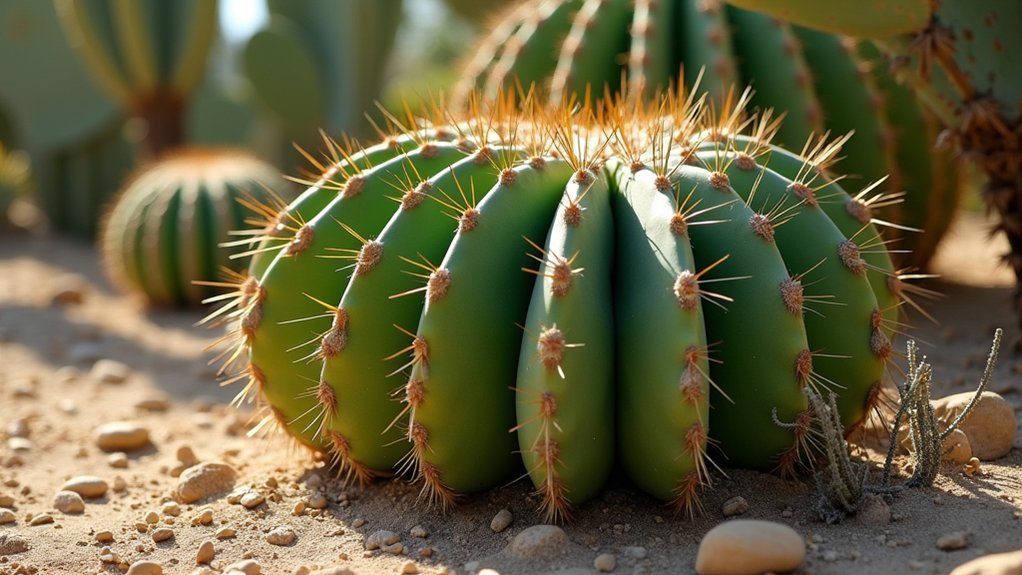
When considering a natural security solution for desert properties, Prickly Pear (Opuntia spp.) stands out as nature’s barbed wire. Growing up to 5 feet tall and wide, these cacti create an impenetrable dense barrier with their spine-covered, paddle-shaped pads that effectively deter both animals and intruders.
You’ll appreciate this drought-tolerant option for your low-maintenance gardens, as it thrives in well-drained soils and requires minimal water.
Beyond security, Prickly Pear offers unexpected beauty with vibrant flowers that create visual interest while attracting beneficial pollinators to your landscape.
As an added bonus, many varieties produce edible fruits called “tunas” that you can harvest for culinary purposes, making your defensive barrier functional in multiple ways.
Desert Willow (Chilopsis Linearis): Flowering Boundary Solution
While Prickly Pear offers ground-level protection, Desert Willow (Chilopsis linearis) provides an elegant vertical solution for your natural desert fence needs. This drought-tolerant tree reaches 15-25 feet tall, creating privacy while enhancing your arid landscape with its colorful, trumpet-shaped blooms.
- Water-wise champion – Thrives in well-drained soil with minimal irrigation once established, perfect for xeriscaping projects.
- Pollinator paradise – Attracts bees and hummingbirds with fragrant pink, white, or purple flowers all summer.
- Quick establishment – Rapid growth rate means you’ll enjoy privacy sooner rather than later.
- Climate resilient – Hardy in USDA zones 7-11, withstanding extreme heat and drought conditions while maintaining its delicate, willow-like appearance.
Jojoba (Simmondsia Chinensis): Evergreen Border Shrub
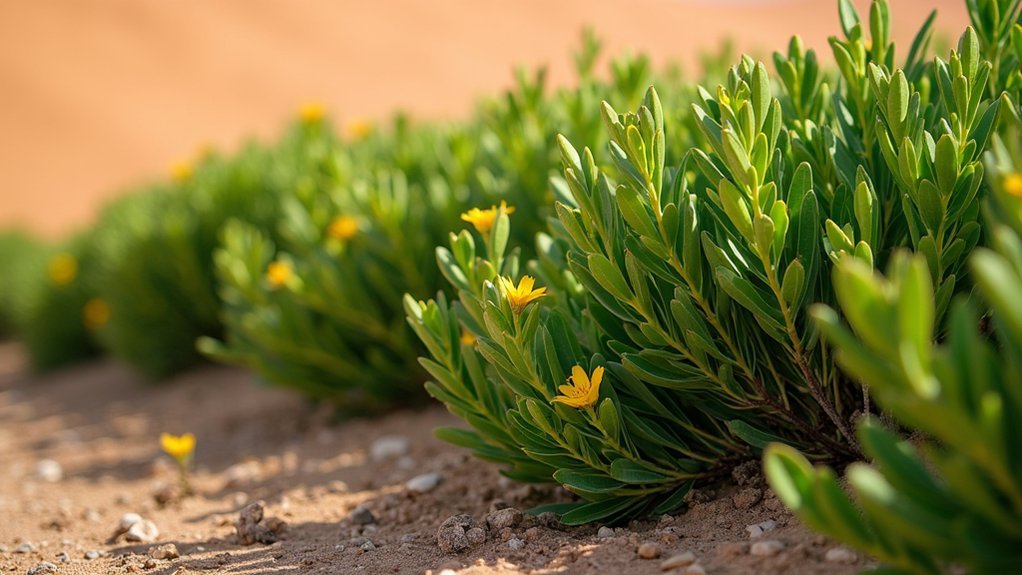
You’ll appreciate jojoba’s impressive growth into a 3-10 foot evergreen border that thrives in the harshest desert conditions with minimal care.
Its dense growth habit creates an effective natural fence that can be shaped through pruning while maintaining year-round coverage.
The plant’s waxy leaves reduce water loss and reflect sunlight, helping it survive extreme heat while giving your property boundary a silvery-green appearance that complements other desert landscaping.
Growth and Resilience
Jojoba stands out as a powerhouse of desert resilience, naturally forming dense barriers that combine functionality with ecological benefits. This evergreen shrub thrives in arid environments where other plants struggle, making it perfect for your natural fence needs.
- Impressive size – Grows 3-10 feet tall with a 4-10 foot spread, creating an effective privacy screen.
- Extreme drought-tolerance – Requires minimal water once established thanks to its leathery leaves that reduce moisture loss.
- Environmental benefits – Performs nitrogen fixation that improves soil health without additional fertilizers.
- Biodiversity support – Produces attractive yellow flowers that attract pollinators to your desert landscape.
You’ll appreciate jojoba’s ability to withstand intense heat while contributing positively to your garden’s ecosystem—a true workhorse of drought-tolerant natural fencing.
Waxy Leaf Benefits
The waxy coating on jojoba’s distinctive leaves serves as nature’s perfect adaptation to harsh desert conditions. This natural armor considerably reduces moisture loss, allowing the plant to thrive in arid desert environments where water is scarce.
You’ll appreciate how these hardy shrubs maintain their vigor with minimal irrigation, making them an excellent low-maintenance option for your xeriscaping projects.
What’s more, jojoba tolerates poor soil conditions remarkably well, eliminating the need for soil amendments or fertilizers. In spring, the plant produces small yellow flowers that attract pollinators, enhancing your garden’s biodiversity.
When planted 3-5 feet apart, these 4-5 foot tall evergreens create an effective natural barrier that remains vibrant year-round, combining practical function with ecological benefits in your desert landscape.
Agave Species: Architectural Boundary Markers
Sentinels of the desert landscape, agave plants offer dramatic architectural forms that make them ideal natural boundary markers.
These drought-tolerant powerhouses can reach impressive dimensions—up to 6 feet tall and 10 feet wide—creating striking visual barriers that define your property lines with minimal watering requirements once established.
- Natural Security – Their sharp spines serve as effective deterrents against unwanted intruders and animals while enhancing privacy.
- Low-Maintenance Design – Thrive in full sun exposure and well-drained soil with almost no intervention needed.
- Eco-Friendly Choice – Support sustainable landscaping with their minimal water needs in arid environments.
- Striking Aesthetics – Provide year-round structure with their bold, symmetrical forms that stand out in desert gardens.
Texas Sage (Leucophyllum Frutescens): Drought-Tolerant Perimeter Planting

While agaves define landscapes with their bold, architectural presence, Texas Sage (Leucophyllum frutescens) offers a softer yet equally effective approach to natural boundary creation.
This drought-tolerant shrub thrives in USDA zones 8-11, reaching heights of 3-5 feet with a spread of up to 4 feet—perfect dimensions for a natural barrier.
You’ll appreciate its silver-gray foliage that conserves moisture while reflecting harsh sunlight in hot environments.
After rainfall, Texas Sage rewards you with lavender to purple blooms that introduce vibrant color to your landscape while attracting important pollinators like bees and butterflies.
For your xeriscaping or low-water gardens, this perennial requires minimal maintenance once established.
Desert Ironwood (Olneya Tesota): Long-Lasting Living Border
For landscapes requiring a robust living fence that withstands even the harshest desert conditions, Desert Ironwood (Olneya tesota) stands as an exceptional choice. This remarkable tree thrives in USDA zones 8-11, reaching heights up to 30 feet while establishing itself in poor, rocky soils typical of arid landscapes.
- Its dense, dark wood resists decay and insects, ensuring your natural fence remains sturdy for decades.
- Purple blooms attract pollinators, boosting your garden’s biodiversity while serving as a functional barrier.
- An extensive root system taps into groundwater, making it drought-tolerant and low-maintenance.
- The tree’s impressive height and spread create an effective privacy screen that adapts to challenging desert environments with minimal intervention.
Planning and Maintaining Your Desert Plant Fence
Because desert plants require specific conditions to thrive as natural barriers, careful planning and consistent maintenance will determine the success of your living fence.
Select drought-tolerant species like creosote bush and ocotillo, spacing them 6-12 feet and 5-10 feet apart respectively to prevent overcrowding and promote healthy growth.
Create visual appeal by incorporating plants with varying heights and textures. Your desert fence will flourish in well-drained, sandy soils that mimic their natural habitat.
Remember to monitor soil drainage carefully—overwatering can cause root rot in these arid-adapted species.
You’ll need to prune your living fence annually to maintain its shape and remove damaged branches.
This regular maintenance not only preserves the fence’s functionality but also enhances its aesthetic value, giving you a beautiful natural boundary that thrives in harsh desert conditions.
Frequently Asked Questions
What Is the Most Resilient Desert Plant?
The Creosote Bush stands as your most resilient desert plant choice. It survives extreme drought, reaches 12 feet tall, and thrives in hardiness zones 7-11 with remarkable longevity and adaptability.
What Desert Plants Don’t Need Water?
You’ll find several desert plants barely need water: Creosote Bush, Brittlebush, Honey Mesquite, Saguaro cactus, Desert Sage, and Ocotillo all survive with minimal irrigation once established. They’ve evolved remarkable drought adaptations.
What Are the Most Heat Tolerant Desert Plants?
You’ll find the most heat-tolerant desert plants include the Giant Saguaro Cactus (surviving 120°F), Creosote Bush, Agave species, Ocotillo, and Palo Verde trees with their photosynthesizing green bark. They’re remarkable survivors!
What Is the Most Drought-Resistant Plant?
For extreme drought resistance, you’ll find Creosote Bush (Larrea tridentata) outperforms most plants. It thrives in arid environments, surviving months without water thanks to its specialized adaptations and extensive root system.
In Summary
You’ve discovered how these ten resilient desert plants can transform your property boundaries into living, thriving barriers. They’ll provide privacy, security, and beauty while conserving water and supporting local wildlife. Whether you choose the dramatic silhouette of Ocotillo or the dense protection of Prickly Pear, you’re creating a sustainable alternative to traditional fencing that celebrates your region’s unique ecology.

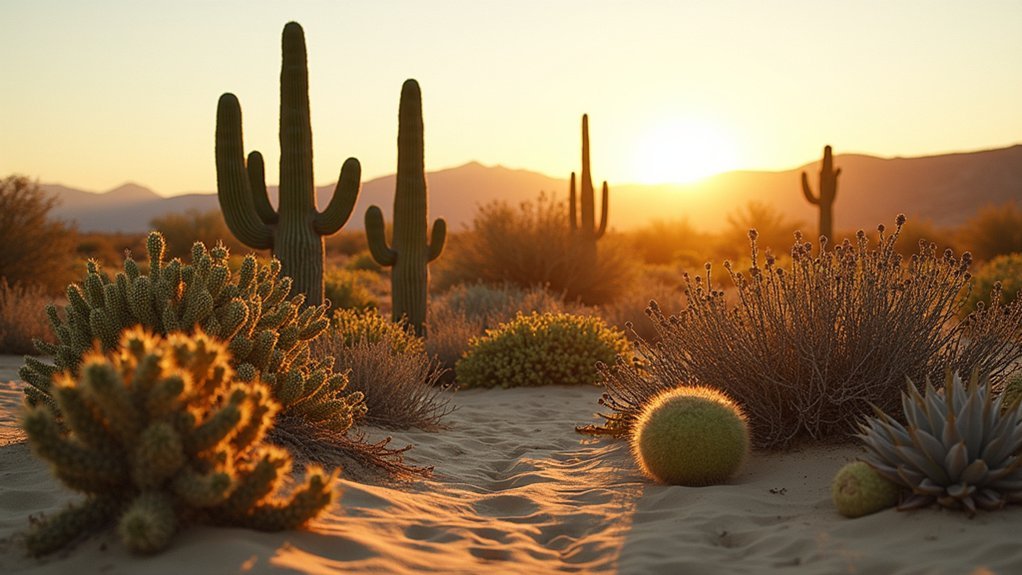

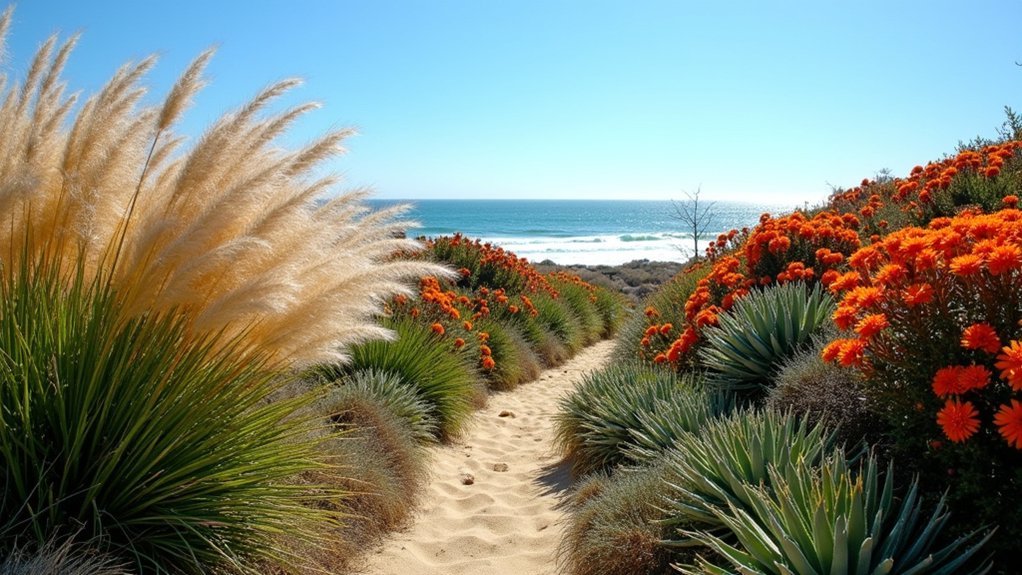
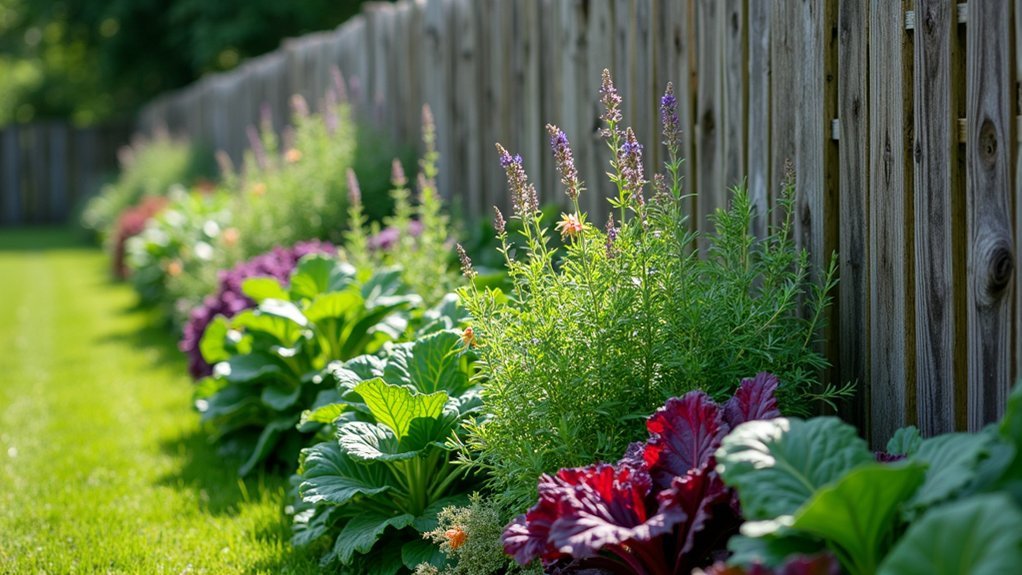
Leave a Reply